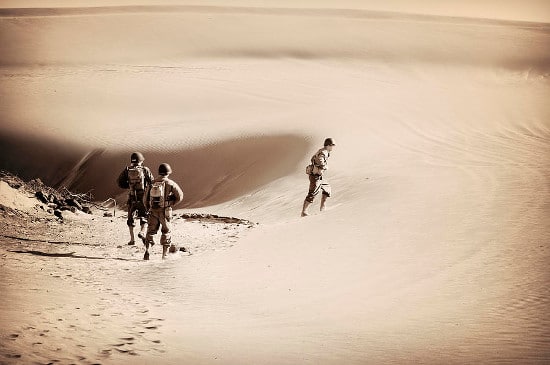
We’ve covered the 3 P’s of Manhood (protect, procreate, and provide), and we’ve distilled them down to the fundamentals — the ancient, nearly universal standards of manhood that have existed around the world for thousands of years.
But in studying them, one can’t help but notice that their requirements are not exclusively manly. Haven’t women played a part in these roles, not just now, but since time immemorial? Is it possible then to drill down through these fundamentals even further, to find the role and its attendant attributes that are, if not exclusively manly, then the most distinctively masculine — the very core of manhood?
If we look at the procreator and provider imperatives, we find that they are roles that men and women share – and that what is distinctively masculine about them comes down to a difference in emphasis.
In the procreator role, it most certainly takes two to tango. The emphasis is simply placed on the man taking the initiative in getting the proceedings started.
In the provider role, men and women have shared the responsibility for contributing sustenance to their families since the dawn of time. Here the emphasis is on the husband contributing more than the wife, and making a more vital contribution (protein vs. plants, in premodern times).
It is then the charge to protect that emerges as the most distinctively masculine of the 3 P’s of Manhood. Because this role involves both defending and conquering, it might be better termed as the way of the warrior. The role of warrior/protector has been almost exclusively male up until the present day, and continues to endure nearly unchanged in the modern era.
Even in the most progressive of families, when something goes bump in the night, the man will not send his wife to investigate while he huddles under the covers. When the car stalls in the middle of nowhere, a man will not send his wife to walk miles in search of the nearest gas station while he stays to wait with the kids in the locked car.
On a national level, though all combat positions in the US military, including the Special Forces, have and will possibly be opened to women (some positions are currently being studied, and may remain closed in the future pending those results), this role will almost certainly remain nearly exclusively male for reasons both of motivation and aptitude. Women currently make up only 15% of the military’s ranks. Of that 15%, less than 8% are interested in pursuing combat positions. And of that 8%, a third would like to work on the aviation side — as part of helicopter crews that provide support for special operations forces. At the same time, it is yet unclear what percentage of this already small fraction of women willing to serve will be able to pass the physical standards required, unless those standards are lowered (and military men and women alike are unanimous that they should not be changed). For example, the implementation of a new standard requiring all Marine Corp boot camp recruits to pass a pull-up test (women can currently pass the test by doing a flexed-arm hang) was delayed when it was found that more than half of the female Marines could not do the minimum of 3. And of the 14 women who have so far attempted to complete the grueling Marines’ Infantry Officer Course, all have washed out — all but one of them on the first day.
These kinds of numbers are similar to those in militaries that have a longer history of opening combat roles to women. For example, in the Israeli military, only 3% of female soldiers work in combat positions — and a large percentage of that small fraction are part of what is essentially a military police/border patrol unit.
Perhaps most tellingly, the announcement that the US military would open combat positions to women was not accompanied by an announcement that all American women would now be required to sign up for the Selective Service, as all males are currently obligated to do. If WWIII broke out tomorrow, America would not be sending its women to the frontlines en masse.
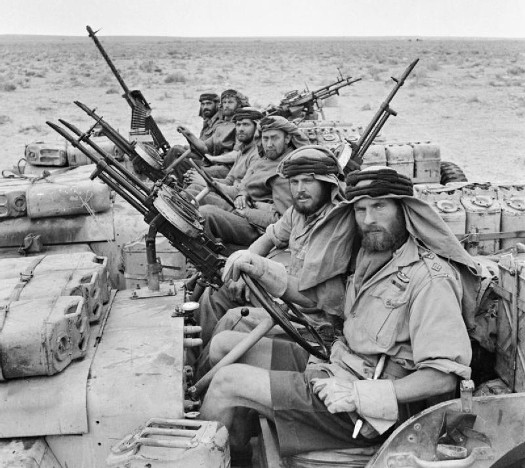
The protector role is not only the most distinctively masculine duty, it is also the manly imperative that makes the others — as well as all the higher virtues — possible.
A man can’t provide or procreate if he and his people are under attack and are taken captive and/or subjugated by an enemy. In times of war and crisis, those other roles are put on hold — all that matters is a man’s worth as a protector. Think of our most recent worldwide crisis; in WWII, men shipped out to serve as protectors, women shifted to take over the now vacant provider role, and procreation was put on hiatus, awaiting a post-war baby boom.
You may believe that a real man cultivates his mind, or does creative work, or shares his feelings openly, or happily plays tea party with his daughter, or loves Jesus. But none of those things — no philosophizing, or worshipping, or reading, or parenting — is possible…if you and your loved ones are dead.
Thus, I think it can clearly be argued that the very core of traditional manhood is the protector role, and every attribute that is most distinctly masculine is tied to that role. It’s the foundation for both being good at being a man and being a good man.
Man-at-Arms
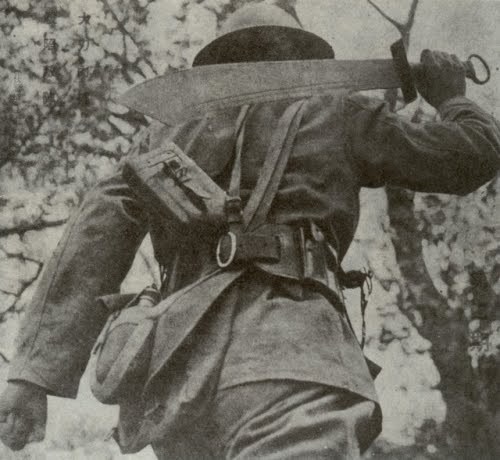
When an ethnographic survey was done of 70 cultures around the world to look for the prevalence of female warriors, 87% restricted women from any kind of participation in war. What accounts for this?
We have touched on the reasons men have historically been given the warrior role in previous posts, but I think they could use a little reiterating and expansion. Men were not assigned the protector role arbitrarily, but because of basic biological and psychological differences between males and females — differences that encompass both motivation/temperament and aptitude/effectiveness.
Motivation/Temperament
The warrior role fundamentally involves the giving and receiving of violence, and men likely have violence built into their very DNA. Harvard biological anthropologist Richard Wrangham argues that men are the product of millions of years of evolutionary selection for aggression. Although we think of chimpanzees as cute and cuddly, among our closest primate relatives, violence is in fact ubiquitous. Male chimpanzees form small raiding parties that go to war with neighboring gangs, fight over territory, and conduct border patrols — viciously attacking and killing any rival gang member that comes too close to the perimeter of their realm. These patriarchal primates are highly concerned about “alpha†status and will kill simply for the sake of power and respect — to show they can do it and should not be messed with.
Occasionally a few females will accompany the males on these border patrols, but they will drop off as the males approach the perimeter. Sometimes a lone female — one who typically does not have children — will accompany the gang right up until the start of the skirmish. But as the male chimps start to pile on an interloper, she will pull away and watch, choosing not to participate in the melee.
Thus it can be argued that human males are products of millions of years of blood-soaked-bellum. In a recent interview, Wrangham posited that “males are predisposed by their evolutionary background to take advantage of opportunities to be violent.†Men, he says, “are violent by temperament.†The police forces, governments, and social mores of modern civilization now check this primordial instinct, but in premodern times the male proclivity for aggression had much freer reign and opportunity to be exercised.
[Because I know someone will bring it up — yes we are also related to the more peaceful, matriarchal bonobos. Bonobos resolve conflict with sex, rather than violence. Researchers speculate that male bonobos may have the potential for violence, but this proclivity is kept in check by groups of “alpha females.†An innate predisposition for violence does not mean it can’t be tempered by cultural constraints. In this way, as we shall see in a later post, bonobos are much like modern humans.]

While the prevailing view among anthropologists was long that hunter/gatherer tribes were very peaceful — bucolic, noble savages — many modern researchers like Wrangham, Napoleon Chagnon, and Steven Pinker convincingly argue that just the opposite is true. Amongst premodern peoples who lived in proximity to neighboring tribes, there is strong evidence that conflict was in fact continual and quite bloody. Primitive human males literally aped their ancestors — forming small gangs, competing for status, and fiercely maintaining boundaries. In the few tribes that did allow women to take part in raiding parties, just like as with the chimpanzees, typically only one or two childless women would choose to come along.
Thus, an innate attraction to and greater comfort with violence likely naturally drew men to the way of the warrior and made them well-suited for being tasked with the role of protector.
Aptitude/Effectiveness
Though in every tribe there were likely a few women with the temperament and desire to be warriors, most cultures still chose to keep the protector role exclusively male.
In our modern times of relative peace and prosperity, this strikes us as inherently unfair. We are used to viewing all roles through the prism of individual proclivities, so that if a woman has the aptitude and motivation to serve as a protector, she should be allowed to fulfill her human potential.
But in primitive times, what mattered most were not individual desires, but the needs of the group — that which helped the tribe survive as a whole trumped everything else.
Even if one does not agree with the leap Wrangham makes from chimp to human violence (fact: with any anthropological theory there is great controversy!), there are also several very straightforward, biological reasons why men were felt to be the most effective fighters and thus solely charged with the imperative to protect.

First, because men will never be pregnant or nursing, they will always be hypothetically the most battle-ready and most able to leave home at any time to fight many miles away.
Second, males’ greater amounts of testosterone make them well-suited for the warrior role for a couple of reasons. First, testosterone is linked with a greater desire to compete and take risks. Studies show that when a man “wins†in a contest, he is hit with a boost of dopamine and a surge of testosterone that makes him want to keep on competing. So while testosterone doesn’t directly make men more aggressive (that’s a myth — it’s more complicated than that), it does fuel a drive to keep pushing when someone else is pushing back.

“The shoulders and arms of male humans – like the neck muscles of red deer, the clasping hands of a xenopus frog, or the canine teeth of many other primates – look like the result of sexual selection for fighting. All these examples of male weaponry respond to testosterone by growing. They are specialized features that enlarge for the specific purpose of promoting fighting ability in competition with other males. Small wonder, then, that men show off to each other before fights by hunching their shoulders, expanding their arm muscles, and otherwise displaying their upper-body strength.†–Richard Wrangham
Testosterone also helps men build greater physical strength than women. In a time before technological innovations in war, all combat was incredibly physical — often of the man-to-man, hand-to-hand variety. Physical size and strength (especially of the upper body) was a vital component of a warrior’s prowess in battle, and men are taller on average than women and have a higher ratio of muscle to fat tissue. Overall physical hardihood was crucial as well, and men have denser bones and are less prone to injuries resulting from strenuous movements and physical contact.
Finally, in primitive times, keeping one’s population growing was paramount, and thus wombs were valued much more highly than sperm, and men were seen as more expendable. It was a simple matter of survival arithmetic: if a population has 50 men and 50 women, and 25 men and 25 women are sent out to fight, and the warriors come back from battle with 20 men and 10 women still alive, there are now 35 women left who can carry a child, and 30 men who can possibly impregnate them (some men will not get to father a child). 35 is thus the maximum number of children that can be born in the next 9 months. But if the group of warriors sent out had consisted of 50 men, and 30 came back alive, those 30 men can impregnate all 50 of the remaining women (some men will impregnate more than one woman). Now there are 50 hypothetical children that can be born in the coming year.
Even if there was an elite woman in the tribe who was drawn to the masculine virtues and just as capable and strong a fighter as one of the weaker men, that was one womb that could not be spared. Such a calculation sounds horribly crude and offensive to us, but this was the basic calculation our hunter/gatherer forbearers made for thousands of years. When the size of one’s village mattered both as a deterrent to an enemy’s attack, and simply the hope that your people’s line would go on, every potential child mattered.
These were the factors that our forbearers weighed on the scale in making the decision to assign the protector role to men. It wasn’t a matter of plain sexism, and trying to keep women down, but a basic biological calculation. In a harsh environment that was rife with perils both natural and human, it was a strategic decision designed to increase a tribe’s chances of survival and keep the most people alive. Individual desires and differences were trumped by group needs.
Keeping the Perimeter
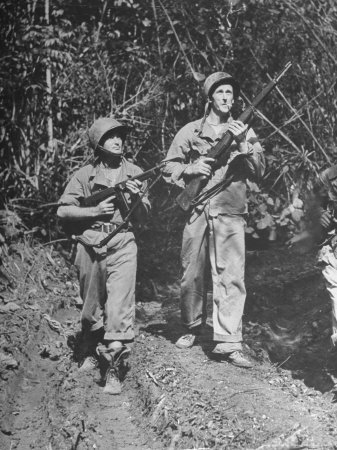
“When men evaluate each other as men, they still look for the same virtues that they’d need to keep the perimeter. Men respond to and admire the qualities that would make men useful and dependable in an emergency. Men have always had a role apart, and they still judge one another according to the demands of that role as a guardian in a gang struggling for survival against encroaching doom. Everything that is specifically about being a man—not merely a person—has to do with that role.†–Jack Donovan, The Way of Men
As I’ve been working on this series, thinking through the tradition of manhood, and attempting to synthesize Gilmore’s findings and the manifestations of the manly code in different cultures, boy, it’s really tasked my brain. When my mind got tied up in knots and the meaning of manhood became seemingly impenetrable and obscure, I often found myself thinking about the definition of masculinity laid out in Jack Donovan’s The Way of Men.
While I don’t agree with all of Donovan’s positions (and as we’ll see in the last post in this series, I come to a different conclusion about manliness in the modern day), for a powerfully stripped down examination of the essence of manhood, his thesis is without rival. In its raw simplicity it is compelling and potently convincing.
Donovan essentially comes to the same conclusion that I have — that when you distill the essence of masculinity — of being good at being a man — down to its very core, what you find is man as protector; literally, man as guardian of boundaries. (The traits that make for a good warrior are also those that make for excellence in that most manly of the provider roles as well — hunting). Donovan arrives at this conclusion by imagining the qualities that would have been most needed and respected in men in the harshest of environments:
“You are part of a small human group fighting to stay alive.
The reason why doesn’t matter.
Conquest, war, death, hunger or disease—any of The Horsemen will do.
You could be our primal ancestors, you could be pioneers, you could be stranded in some remote location, you could be survivors of a nuclear holocaust or the zombie apocalypse. Again, it doesn’t matÂter. For humans without access to advanced technology, the scenario plays out more or less the same way.
You have to define your group. You need to define who is in and who is out, and you need to identify potential threats. You need to create and maintain some sort of safe zone around the perimeter of your group. Everyone will have to contribute to the group’s survival in some way unless the group agrees to protect and feed someone who can’t contribute due to age or illness. For those who can work, you’ll need to decide who does what, based on what they are good at, who works well together and what makes the most practical sense…
If there are females in your group, they will have plenty of hard and necessary work to do. EvÂeryone will have to pull their own weight, but the hunting and fighting is almost always going to be up to the men. When lives are on the line, people will drop the etiquette of equality and make that decision again and again because it makes the most sense…
The first job of men in dire times has always been to establish and secure “the perimeter.â€
People can’t fight and hunt and kill all day and all night forever. Humans have to sleep, they have to eat, and they need downtime. You need to create a safe space and set up camp somewhere.
You’ll also have to identify some desirable resources, like access to water and food. One of the first things you have to consider is whether the spot makes you vulnerable to attack from predators or unknown groups of men. Then you do some basic recon—you check out the surrounding area to see if there is evidence of another tribe, or undesirable beasts. Tired and satisfied, you and your pals set up a base camp and keep an eye on a rudimentary perimeter.
The survival of your group will depend on your ability to successfully claim land and keep it safe.
When you claim territory and draw a perimeter, that line separates your group from the rest of the world. The people inside the perimeter become us and everything known and unknown outside the perimeter becomes them.
Beyond the light of your night fire, there is darkness. They lie just beyond the flicker of your fire, out there in the dark. They could be wild animals, zombies, killer robots or dragons. They could also be other men. Men know what men need, and what they want. If your men have something that men want or need, you’ll have to be wary of other men. The things that have value to men—tools, food, water, women, livestock, shelter or even good land—will have to be protected from other men who might be desperate enough to harm you to get those things. The perimeter separates men you trust from men you don’t trust, or don’t know well enough to trust.â€
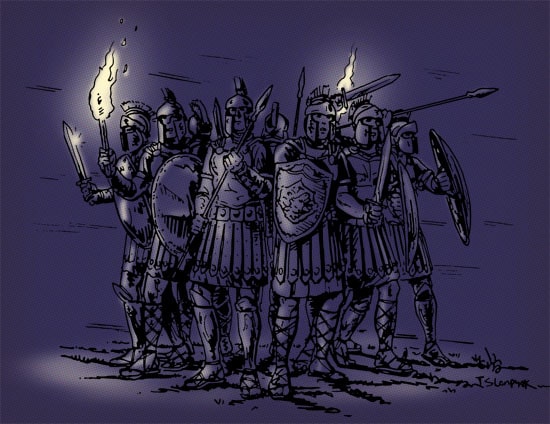
Donovan argues that the way of men is the way of the gang, because when placed in a harsh environment, men will quickly make the logical calculation that they have a much better chance of surviving if they band together than if they each try to go it alone. For some folks, “gang†is a word weighted with negative connotations, so substitute “posse†or “platoon†or whatever else if you must. The important thing to realize is that the small, tightly-knit honor group was the basic male social unit for eons. The myth of the uber-manly lone wolf is just that. With few exceptions, men have always fought and hunted together. Cowboys banded together, pioneers banded together, and Rambo wouldn’t have actually stood a chance.
Donovan argues that understanding the dynamics of these ancient honor groups is the key to understanding the essence of male psychology and how men relate to, interact, and judge each other even up through the modern day. What men respect in other men (and women find attractive), is rooted in what men wanted in the men to the left and the right of them as they stood together side-by-side on the perimeter.
To understand what men have needed from each other for thousands of years, let us turn back to our guardians huddled on the boundary between safety and threat:
“If you are fighting to stay alive and you are surrounded by potential threats, what do you need from the men fighting with you?
What do you need from us to fend off them?
If eating means facing danger together, who do you want to take with you?
What virtues do you need to cultivate in yourself and the men around you to be successful at the job of hunting and fighting?
When your life and the lives of people who you care about depend on it, you’ll need the men around you to be as strong as they can be. Living without the aid of advanced technology requires strong backs and elbow grease. You’ll need strong men to fight off other strong men.
You won’t want the men in your gang to be reckless, but you’ll need them to be courageous when it matters. A man who runs when the group needs him to fight could put all of your lives in jeopardy.
You’ll want men who are competent, who can get the job done. Who wants to be surrounded by morons and f**k-ups? The men who hunt and fight will have to demonstrate mastery of the skills your group uses to hunt and fight. A little inventiveness couldn’t hurt, either.
You’ll also need your men to commit. You will want to know that the men beside you are us and not them. You’ll need to be able to count on them in times of crisis. You want guys who have your back. Men who don’t care about what the other men think of them aren’t dependable or trustworthy. If you’re smart, you will want the other men to prove they are committed to the team. You’ll want them to show that they care about their reputation within the gang, and you’ll want them to show that they care about your gang’s reputation with other gangs.â€
The Tactical Virtues

“The virtues associated specifically with being a man outline a rugged philosophy of living—a way to be that is also a strategy for prevailing in dire and dangerous times. The Way of Men is a tactical ethos.†–Jack Donovan, The Way of Men
To the description of the ideal perimeter-keeper outlined above, Donovan assigns four “tactical virtuesâ€: strength, courage, mastery, and honor. These are “simple, amoral, and functional virtues†— “the practical virtues of men who must rely on one another in a worst case scenario.†They are “amoral†because they are crucial to the success of any gang — no matter if what they’re fighting for is right or wrong. Strength, courage, mastery, and honor are the attributes needed in a team of Navy SEALs just as much as a family of Mafioso. If you’ve ever wondered why we are fascinated by gangsters, pirates, bank robbers, and outlaws of all stripes, and can’t help but think of them as pretty manly despite their thuggery and extralegal activities, now you know; they’re not good men, but they’ve mastered the core fundamentals of being good at being men.
Let’s take a quick look at what these tactical virtues require:
- Strength: Physical prowess and power; ability to dominate an opponent (of the natural or human variety) instead of being dominated, and to stand fast and immovable when pushed.
- Courage: The spirit /will/discipline to engage and employ one’s strength when inwardly tempted to shrink/run/hide. There are “higher†forms of courage, but at its most fundamental, it represents an outwardly demonstrated indifference to risk, pain, and physical danger.
- Mastery: Skill and adeptness in using the techniques and technology employed in hunting and fighting; a deft understanding of knowledge that saves lives and furthers the interests of your group.
- Honor: Traditional honor is not the same as integrity — living up to your own, personal standards. Traditional honor is a reputation for strength, courage, and mastery — as judged by other men. Honorable men care about being manly, knowing that each individual member’s prowess in the tactical virtues bolsters the strength and reputation of the gang as a whole and thus deters attack from rival gangs. Dishonorable men, on the other hand, evince indifference or hostility to the standards, weakening the group and leaving it more vulnerable.
The key to upholding honor in a male gang is to always try to pull your own weight – to seek to be a boon rather than a burden to the group. If a man lacks in physical strength, he might make up for it in the area of mastery – being the group’s best tracker, weapons-maker, or trap inventor; one crafty engineer can be worth more than many strong men. If a man lacks in both physical strength and mastery, he might still endear himself to the other men with a sense of humor, a knack for storytelling, or a talent in music that keeps everyone’s spirits up. Or he might act as a shaman or priest – performing rituals that prepare men for battle and cleanse and comfort them when they return from the front. The strong men of the group will usually take care of the weak ones who at least try to do whatever they can. Shame is reserved for those who will not, or cannot excel in the tactical virtues, but don’t try to contribute in some other way, and instead cultivate bitterness and disregard for the perimeter-keepers who ironically provide the opportunity to sit on one’s hands and carp.
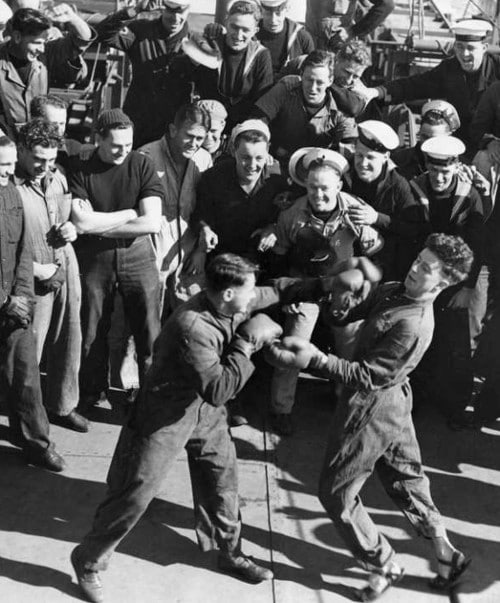
Men compete within a team to earn honor and show who in the group has the most prowess in the tactical virtues. At the same time, this intra-group competition prepares the team to face rival/enemy gangs.
Strength, courage, mastery, and honor are virtues that obviously aren’t exclusive to men, and it’s not that there haven’t been women who have embodied these traits in every age (as we shall see next time, the idea of a soft, fragile femininity is a modern conception). It isn’t that women shouldn’t seek these attributes either. Rather, the tactical virtues comprise the defining traits of masculinity. If a woman isn’t strong or acts afraid in the face of danger, no one thinks of her as less womanly because of it. Yet such shortcomings will be seen as emasculating in a man, even today.
So what are the defining traits of femininity? Oh-hoho, I’m not going to touch that with a ten-foot pole. It’s taken me years to understand manhood, and I’m still refining my views. I wouldn’t appreciate it if a woman who hadn’t rigorously studied masculinity offered an off-the-cuff definition for it, so I will refrain from doing likewise. Someone should start an awesome Art of Womanliness-type blog and explore the subject. I’ll be a reader.
The Linchpins of Civilization
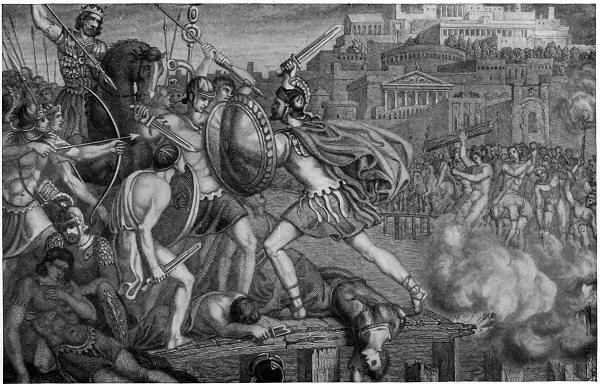
“Strength, Courage, Mastery, and Honor are the alpha virtues of men all over the world. They are the fundamental virtues of men because without them, no “higher†virtues can be entertained. You need to be alive to philosophize. You can add to these virtues and you can create rules and moral codes to govern them, but if you remove them from the equation altogether you aren’t just leaving behind the virtues that are specific to men, you are abandoning the virtues that make civilization possible.†–Jack Donovan, The Way of Men
The tactical virtues might understandably make some modern folks feel uncomfortable, as they may seem rather raw, primal, and thuggish to contemporary sensibilities, and anything described as “amoral†tends to put people on guard.
This discomfort arises from the fact that, again, the tactical virtues may be employed for good or ill. We may be fascinated by watching the exploits of Vikings on television, but were they poised on the outskirts of our town, ready to pillage and plunder, we would be quaking in our shoes. Gangs of men can wield surprising power against entrenched interests (see the protests around the world these past several years) and turn order into chaos.
Thus in the modern day we are much more apt to cheer and celebrate the higher virtues over the tactical variety.
But in truth the two sets of virtues cannot be separated – one makes possible the other. Without (at least some) men who are good at being men, there would not be the safety and peace that makes possible the unencumbered pursuit of being a good man.
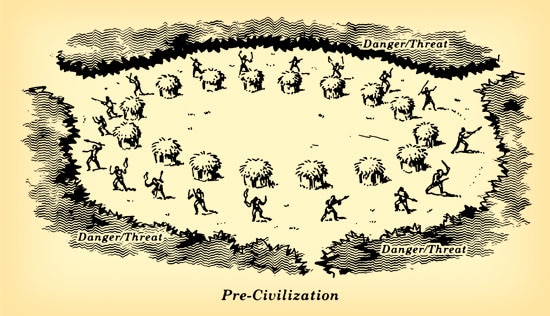
In the direst of times, in the harshest of environments, danger is all around and can come from every direction. People live close to the boundary between safety and threat, and all men must serve on the perimeter and cultivate the tactical virtues of the protector as best they can. Violence is not an option; it is a way of life. At such times, moral and spiritual codes can certainly be present and may strongly motivate and influence men in their fight, but there is significantly less time for rituals, worship, and contemplation. Winning the battle and surviving take top priority and the virtues needed to accomplish that mission – strength, courage, mastery, and honor – are most emphasized.
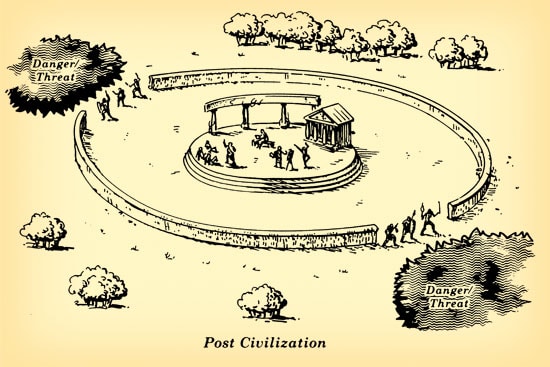
“Men who have accomplished the first job of being men—men who have made survival possible—can and do often concern themselves with being good men. As the bloody boundary between threat and safety moves outward, men have the time and the luxury to cultivate civilized, “higher†virtues.†–Jack Donovan, The Way of Men
As civilization advances, danger and threat recede and become concentrated in more predictable spots along the perimeter. Only these particular borders must be guarded and less men are needed to serve as protectors. People move their settlements farther away from threats to a more comfortable zone of safety where they don’t have to constantly look over their shoulder, and can let down their guard. In these areas of greater peace and plenty, men, now freed from serving as protectors (at least full-time), can concentrate more on the procreator and provider roles and specialize in an area that best matches their interests and talents. There is time and opportunity to develop writing, art, and music, to ponder the meaning of Beauty, Wisdom, Justice, and Truth, and to dream up more just political and cultural systems and increasingly compassionate moral codes. One purpose of these moral codes is to govern male violence – to create rules for when it is and is not appropriate to employ and to channel it towards worthy ends.
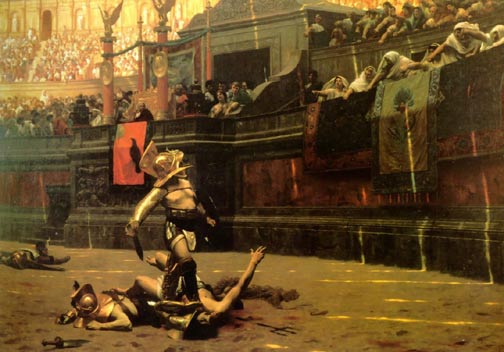
An ideal of manhood and the language of the tactical virtues remain, but the concepts become more metaphorical; strength of body expands to include strength of character; moral and intellectual bravery are added as categories of courage. Rather than seeking to conquer enemy tribes, men seek to “conquer†themselves and “vanquish†their weaknesses. Instead of warring with human combatants, men “battle†cancer and “fight†for rights. The competitions men engage in to prove their manliness also get increasingly abstract; rather than going toe-to-toe on the battlefield, men try to best their fellows in sporting events, debating contests, scientific advancements, and business enterprises. As the circles of abstraction extend even further away from the core of manhood, men content themselves with simply watching other men do these things; the number of doers shrinks while the number of spectators grows. Men read and write about the manly deeds of the past, rather than performing such deeds themselves. Their field of struggle is internal rather than external, and they work on bettering their lives.
This flipping of priorities from an emphasis on being good at being a man, to being a good man is a luxury made possible by the outsourcing of the protector role to what becomes an increasingly small warrior class of men. As George Orwell put it, “men can only be highly civilized while other men, inevitably less civilized, are there to guard and feed them.”
It is quite easy to lose sight of this, especially in our modern society where less than .5% of the population serves in the military (and an even smaller percentage of that sees combat) and wars are fought far, far away. In such a bubble, it’s tempting to get on one’s high horse about men who are too brutish for one’s tastes and how disdainful and unenlightened violence is. But as Orwell also said in regards to pacifism, “Those who ‘abjure’ violence can only do so because others are committing violence on their behalf.â€
Again, however, it is important not to split being good at being a man and being a good man into a strict dichotomy. It is only in our modern age that we tend to see brains and brawn, goodness and strength as mutually exclusive traits. While one set of virtues are prioritized over another depending on circumstances, since the dawn of civilization there have been men who strive for and achieve excellence in both the tactical and higher virtues. And men who excel on either one end of the manliness spectrum or the other, often have a symbiotic relationship. The best warriors are rarely the best writers and the best writers are rarely the best warriors. But the writings of great authors and philosophers have often inspired great warriors, and great warriors have often inspired great writing.
Even the men we hold up as proof that you can be manly by living the higher virtues without completely fulfilling the 3 P’s of Manhood ultimately derive their inspiration from the fundamental underpinnings of the tactical virtues. Figures like Gandhi and Jesus are lauded for their non-violence and their goodness, but our ability to think of them as manly, derives from their embrace of masculine expendability – a courageous indifference to the pain and suffering others might inflict on their physical body. They were good men, certainly, but their willingness to sacrifice themselves for the sake of their people, also made them good at being men.
The Protector Endures
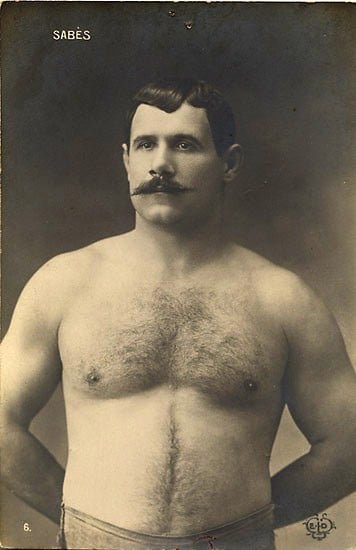
“A man is not merely a man but a man among men, in a world of men. Being good at being a man has more to do with a man’s ability to succeed with men and within groups of men than it does with a man’s relationship to any woman or any group of women. When someone tells a man to be a man, they are telling him to be more like other men, more like the majority of men, and ideally more like the men who other men hold in high regard.†–Jack Donovan, The Way of Men
Even though we now live in the suburbs instead of the savanna, and the vast majority of men aren’t asked to serve as protectors on a day-to-day basis, our propensity for evaluating men in light of the tactical virtues is surprisingly enduring.
When men and women alike look at a man and gauge how manly he is, their immediate, gut-reaction is still based on the tactical virtues – how strong and tough he appears. If you look at the picture above, your instinctive reaction will be to say, “Yep, there’s a manly man right there.â€
If someone asks us if our smart, albeit skinny friend is “manly,†our primal brain’s immediate reaction is to think, “Not really.†We’ll then check this reaction, and look for other factors that might prove our visceral response wrong: “Well, he is manly because he’s a really accomplished engineer.†Likewise, if we are asked if a very obese man who gets winded just climbing a flight of stairs is manly, our brain will initially answer in the negative, but quickly follow up with, “But he is manly because he’s such a good dad.â€
When a man breaks down and cries not because of understandable grief, but because he’s frustrated or demoralized by a setback, a woman’s visceral reaction will often be to recoil at what registers as emasculating behavior. She’ll then push that thought away and tell herself, “No, it’s good that he’s able to express his feelings.â€
When we have this “Not manly…yes manly†reaction, our older, more primal brain responds first, and then after a few beats our modern brain comes online and reevaluates things. Our primal brain reacts to a man the way it did for thousands of years – by gauging whether or not you’d like to have that man on your team were you guarding the perimeter together. Our modern brain then kicks in and reminds us that we’re not surrounded by danger anymore, and that the guy next to us doesn’t need to be strong and courageous – a nice guy who’s honest and kind and laid-back will do just fine. Likewise, when a man does something that would be considered historically emasculating, a woman’s primordial instinct is to worry about his prowess as a protector – would he fall apart in the face of real danger? But the part of her brain that processes modern sensibilities will try to squash that instinctive anxiety: “That’s silly. He doesn’t need to be a protector for me. It’s more important that he’s sensitive.â€
This mental push and pull gets to the heart of today’s “crisis in masculinity.†Should we try to get rid of that initial visceral judgment of men altogether because the tactical virtues are now largely irrelevant and this ancient rubric of manhood leaves out too many men? Should we try to make manhood more inclusive so no one need be excluded or feel bad about their shortcomings? Is continuing to encourage young men to “be a man†and “be tough†damaging to their psyche? Would they be happier without the expectation of toughness and if they were allowed to be more sensitive and able to openly express their feelings at all times? If the way of the warrior is deeply ingrained in men’s psyche, perhaps even in their DNA, what becomes of manliness in a time when this potential and propensity has no real outlet? If we ignore and condemn it will it go away? Can men be content with just participating in (and watching) abstractions of combat and competition? What becomes of the way of the warrior when there are no more wars to be fought?
Suffice it to say, our modern culture is deeply conflicted about the answers to these questions. Exploring the origins of this conflict is where we will turn next time.
Read the rest of the series:
Part I – Protect
Part II – Procreate
Part III – Provide
Part IV – The 3 P’s of Manhood in Review
Part VI – Where Does Manhood Come From?
Part VII – Why Are We So Conflicted About Manhood?
Part VIII – The Dead End Roads to Manhood
Part IX – Semper Virilis: A Roadmap to Manhood
_________________
Sources and Further Reading/Listening:
The Way of Men by Jack Donovan. For a clearer and pithier explanation of the concepts outlined above, you’ll want to read this book. Donovan’s views are controversial, but even if you don’t end up agreeing with his conclusions, it’s worthwhile to read and grapple with his thesis.
Demonic Males by Richard Wrangham and Dale Peterson. Don’t let the name fool you: this is not an anti-male screed. Instead, it’s a completely fascinating look at male violence and its possible origins in primates.
Science Friday: The Origins of Violence. This podcast popped up on Friday and I couldn’t believe how well it aligned with this post. A quick, interesting intro to men and violence.


